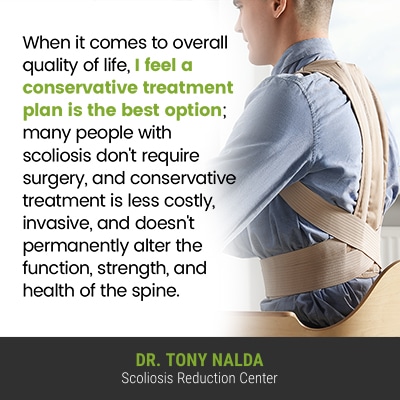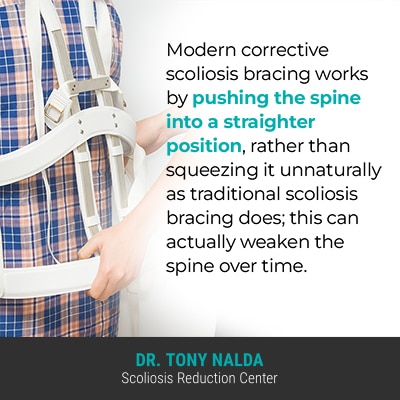It’s important that scoliosis patients are aware of all treatment options available to them because the choice to commit to one type of treatment plan over another can have far-reaching effects. As a progressive condition, there is no curing scoliosis, but it can be highly treatable.
Just as there are different types and severity levels of scoliosis, there are different ways to respond with treatment, and while surgical treatment is still an option, the effectiveness of non-operative treatment, including scoliosis bracing, has proven results.
Before exploring three proven ways to address scoliosis, let’s start with what it means to be diagnosed with scoliosis.
What is Scoliosis?
Scoliosis is a highly prevalent spinal condition that affects all ages and is the leading spinal deformity among school-aged children.
Scoliosis involves the development of an unnatural sideways-bending and rotating spinal curve, and as a progressive condition, the nature of scoliosis is to get worse over time, and the main trigger for progression is growth, which is why scoliosis in children should be taken seriously.

Scoliosis progressing means the size of the unnatural spinal curve is increasing, as are the condition’s uneven forces, and their effects.
When it comes to childhood scoliosis, the main condition effect is postural deviation, and while adults also experience postural changes, the main symptom that brings then in for a diagnosis and treatment is pain.
Scoliosis doesn’t become a compressive condition until skeletal maturity has been reached, and it’s compression of the spine and its surrounding muscles and nerves that causes the majority of condition-related pain; in children, the constant lengthening motion of a growing spine counteracts the compressive force of the unnatural spinal curve.
Scoliosis ranges widely in severity from mild scoliosis to moderate scoliosis and severe to very severe scoliosis, and the more severe scoliosis is, the more likely it is that its effects are going to be noticeable, and it’s important for patients to understand that a scoliotic curve doesn’t just bend unnaturally to the side, but also twists, making scoliosis a complex 3-dimensional condition.
In addition to ranging widely in severity, there are also different types of scoliosis a patient can develop that can cause different symptoms, affect different areas of the body, and have unique treatment needs.
Different Types of Scoliosis
Part of the reason it’s so important that treatment is provided by a scoliosis specialist and not a general practitioner is the highly-variable and complex nature of the condition; no two cases are the same, necessitating the full customization of treatment plans.
The main type of scoliosis that accounts for approximately 80 percent of known cases is idiopathic scoliosis, meaning not clearly associated with a single-known cause, and the remaining 20 percent consist of diagnosed cases associated with known causes: neuromuscular scoliosis, congenital scoliosis, and degenerative scoliosis.
Determining condition type is important because it indicates its underlying cause, and when known, the underlying cause is what treatment plans are shaped around, along with condition severity, curvature location, and patient age.
For example, neuromuscular scoliosis is caused by the presence of a large neuromuscular condition such as cerebral palsy, muscular dystrophy, and spina bifida, so the focus of treatment has to be on the larger neuromuscular condition, and this complicates the treatment process.
So now that we’ve discussed some defining characteristics of scoliosis, let’s address what can be done in response to a diagnosis.
Scoliosis Treatment Options
The most important decision scoliosis patients are faced with is how to treat their condition once a diagnosis has been given.
With more than one treatment option, there are pros and cons to each that patients need to fully understand; as a progressive condition, scoliosis is incurable so how scoliosis is treated will shape a patient’s long-term spinal health and function.
Three proven ways to treat scoliosis include non surgical treatment, corrective bracing, and surgical treatment.
Non-Surgical Conservative Chiropractic Treatment
Non-surgical treatment for scoliosis is known as conservative treatment, and it offers patients a less-invasive surgical treatment alternative.
Conservative treatment is what I offer patients of the Scoliosis Reduction Center®, and this approach is proactive and chiropractic-centered.
First and foremost, as a structural spinal condition, I work towards impacting scoliosis on a structural level through condition-specific chiropractic treatment that can involve a series of techniques and manual adjustments to adjust the position of the curve’s most-tilted vertebrae.

If the vertebrae at the curve’s apex are realigned with the rest of the spine, as much of the spine’s health curves as possible have been restored.
Alongside impacting the condition structurally, treatment also has to impact the spine’s surrounding muscles and nerves, and a curvature reduction can take pressure off the spine’s surroundings, and I use physical therapy and a number of scoliosis-specific exercises and stretches to help strengthen abdominal muscles so the spine can be optimally supported by a strong and stable core.
Physical therapy and the prescription of scoliosis-specific exercises can also help improve posture, counteract curve progression, reduce pain, improve mobility, sensorimotor integration, and can help make the spine more responsive to treatment.
Conservative treatment is integrative; it combines multiple scoliosis-specific treatment disciplines to impact conditions on every level, and this also allows for treatment plans to be fully customized as disciplines can be apportioned accordingly and adjusted based on how conditions are responding to growth and treatment.
The effectiveness of bracing for scoliosis treatment will depend on the brace in question; while traditional bracing is associated with a number of shortfalls, ultra-corrective scoliosis braces like the ScoliBrace can help correct scoliosis and are particularly effective on growing spines.
Modern corrective scoliosis bracing works by pushing the spine into a straighter position, rather than squeezing it unnaturally as traditional scoliosis bracing is known to do; this can actually weaken the spine over time.
As an incurable condition, rehabilitation is key and can involve ongoing chiropractic care and a series of custom-prescribed home exercises to further stabilize and heal the spine from home.
Spine Surgery as Scoliosis Treatment
Scoliosis spinal surgery is a type of spinal fusion that commonly involves fusing the curve’s most-tilted vertebrae into one solid bone, and this is done with the goal of eliminating movement in the fused vertebrae so they can’t become more tilted over time (progression).
This also commonly involves the removal of intervertebral discs that sit between vertebral bodies being fused together, and fusing the spine and removing one or more intervertebral discs is contrary to its natural and movement-based design; there are bound to be repercussions to overall spinal health.
In addition to risks associated with the procedure itself such as excessive blood loss, infection, and nerve damage, the real impact of spinal fusion is felt in the spine’s long-term health, strength, and function.
So while spinal surgery can straighten a bent spine, the way it does so can cost the patient in different ways; a fused spine is weaker and more vulnerable to injury, pain can increase after surgery due to spinal rigidity, and many patients are disappointed with the loss in spinal flexibility and range of motion they’re left with.
When it comes to overall quality of life, I feel a conservative treatment plan is the best option; many people with scoliosis don’t require surgery, and conservative treatment is less costly, invasive, and doesn’t permanently alter the function, strength, and health of the spine.
Conclusion
So while conservative treatment, corrective bracing, and spinal fusion offer proven ways to treat scoliosis, they affect the spine differently, and this is what I want patients to be aware of so they can make informed treatment choices.
For those wanting to forgo a surgical recommendation, or who simply want to try a more natural treatment approach first, modern conservative treatment has proven results that speak for themselves.
Non-surgical scoliosis treatment relies on the power of scoliosis-specific chiropractic care, corrective bracing, physical therapy and scoliosis-specific exercise approaches such as the schroth method, schroth exercises, and the scientific exercises approach (SEAS).
By combining multiple scoliosis-specific treatment disciplines, conditions can be impacted on every level for long-term sustainable results.
When it comes to traditional bracing efficacy versus corrective brace efficacy, the former is limited for a number of reasons: it only addresses scoliosis as a 2-dimensional condition, it squeezes the spine unnaturally, weakening it over time, and as traditional braces aren’t fully customized to suit a patient’s body/curvature type, they are less comfortable, more bulky, and tend to cause compliance issues.
Here at the Center, I spend a lot of time educating patients, and their families, on the pros and cons of different types of treatment so patients can ensure their treatment expectations are aligned with the reality of their potential outcomes.
An unnatural curvature of the spine should always be taken seriously, and as progression is triggered by growth, young patients are the most at risk for conditioned progression; regardless of condition type or severity, the best time to start scoliosis treatment is always now.




